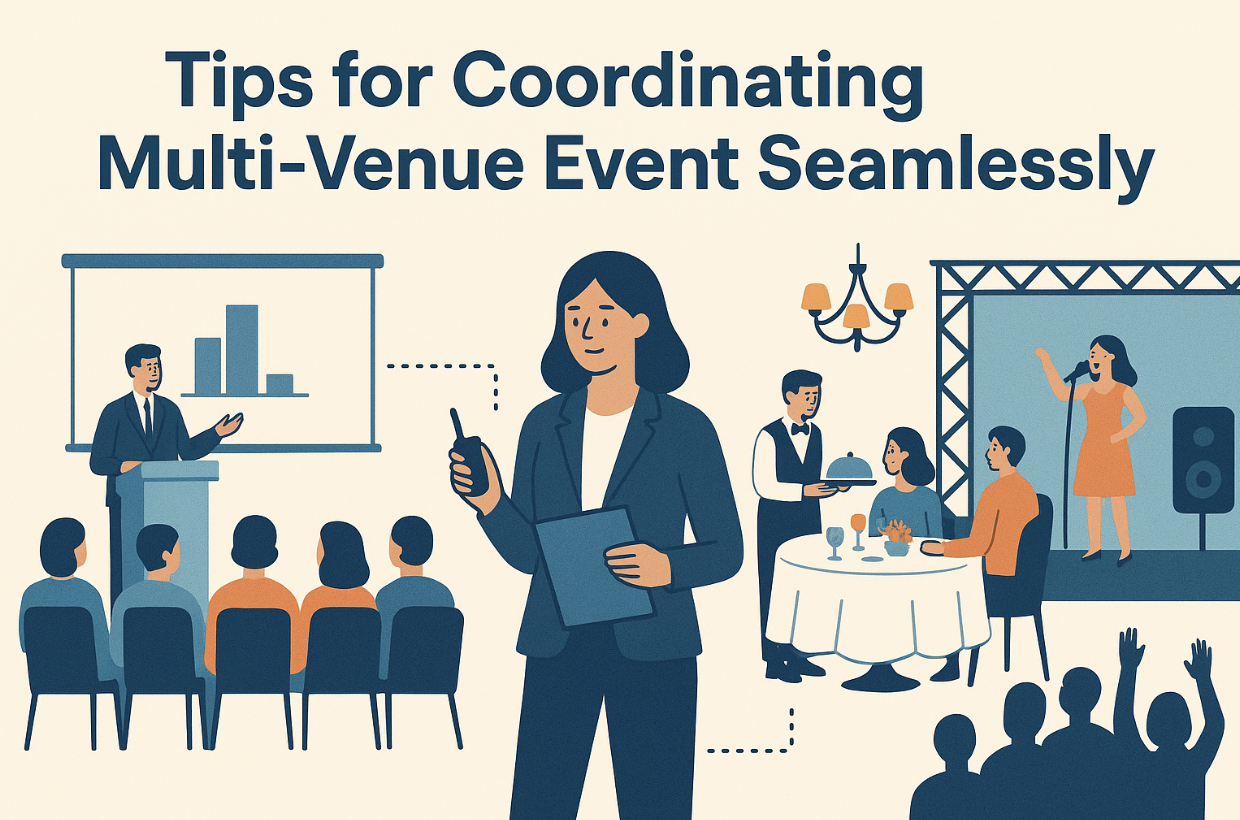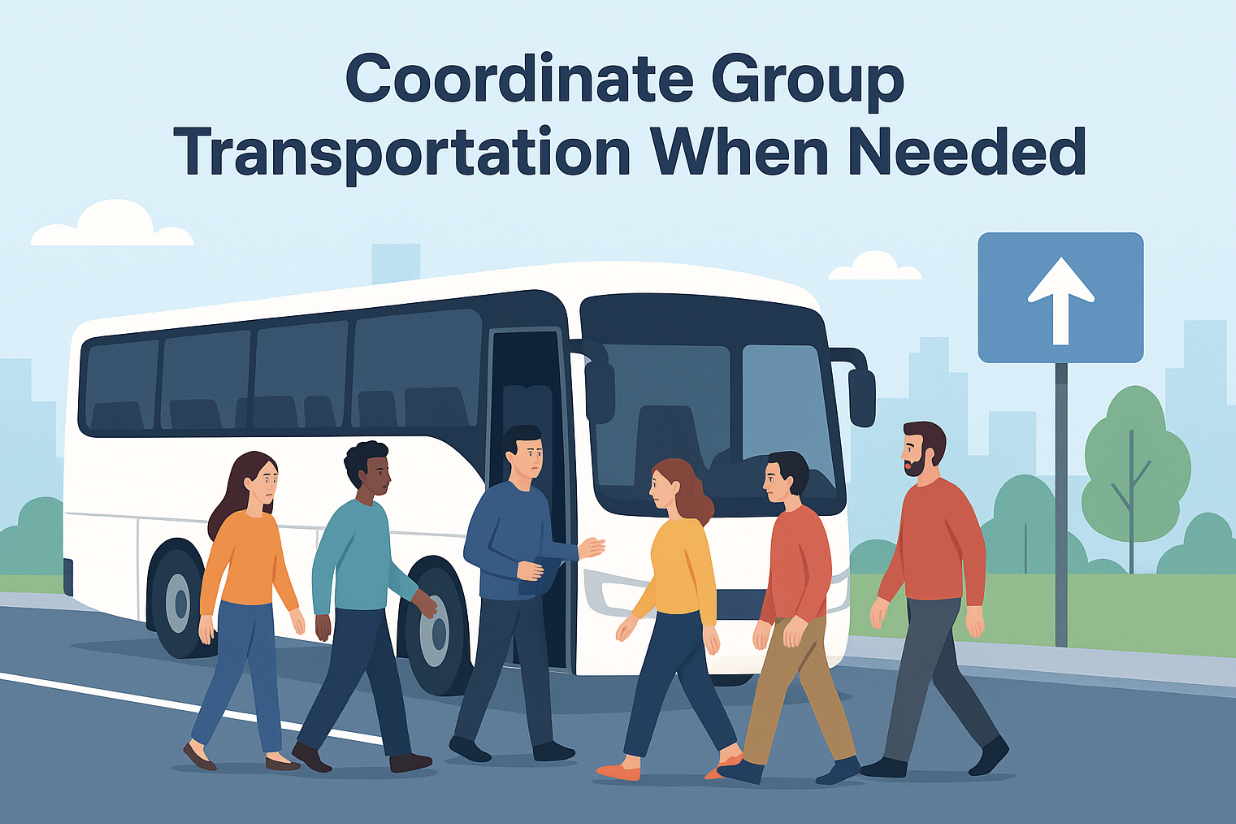Coordinating a single event is hard enough, but managing multiple venues in a single day adds layers of complexity that demand precise planning, clear communication, and flawless execution — especially for event planners and organizers aiming to deliver a seamless guest experience.
Whether you’re organizing a corporate retreat, a progressive dinner party, a wedding with separate ceremony and reception sites, or a multi-stop promotional event, the logistics involved are anything but simple. From transportation coordination and vendor scheduling to guest communication and contingency planning, the moving parts multiply quickly—along with the potential for confusion, delays, and costly oversights.
Even the most experienced event planners can find themselves stretched thin when navigating different locations, timelines, and teams. But, with the right strategy, tools, and mindset, multi-venue event days don’t have to be chaotic. They can become dynamic, memorable experiences that impress guests and clients alike.
This article offers practical, field-tested tips to help you take control of complex event logistics and ensure a smooth flow from one venue to the next.
Tip 1: Build a Master Schedule with Buffer Time
Every successful event begins with a detailed timeline, but for multi-venue events, a master schedule is non-negotiable. This should include exact times or time frames for vendor arrivals, guest transitions, setup and breakdown, as well as the timing of each scheduled activity at each venue.
To ensure smooth transitions, build in extra time buffers between movements and activities—especially when venues have considerable distances between them. Share this timeline with your vendors, venue managers, and planning team to keep everyone on the same page.
Tip 2: Map Routes and Provide Clear Directions
Guests and vendors alike need clarity on how to move from one venue to the next. Be sure to provide detailed driving directions or provide Google Maps directions to each venue. Lastly, including important details like traffic alerts, parking instructions, and venue entrances is a good idea.
This not only helps reduce delays but also makes the experience more enjoyable and less stressful for attendees.
Tip 3: Assign On-Site Coordinators at Each Location
Trying to manage multiple venues personally is overwhelming and unsustainable, which is why you should assign a trusted coordinator to each site. These individuals should be familiar with the layout, vendor roles, and timing specifics. They act as the eyes and ears of the event planner at their assigned location, ensuring swift troubleshooting and smooth implementation of the plan.
Tip 4: Leverage Technology for Real-Time Team Communication
Effective coordination is only possible when communication is fluid and immediate. Utilize project management tools like Trello or Asana for task tracking, and real-time messaging apps like WhatsApp or Slack to share updates instantly. When things shift—as they inevitably do—your team needs to be able to adjust without delay. A shared digital space ensures nothing slips through the cracks.
Tip 5: Manage Time Between Venue Transitions
Multi-venue events live and die by the clock. Even the best-laid plans can unravel if one segment runs long and throws off the rest of the schedule. This is why it’s a great idea to build ample buffer time between sessions or transitions, especially for high-traffic hours or complex load-outs. A 15–20-minute window between key moments gives you just enough time to recover from minor delays without disrupting the flow of the entire day.
Tip 6: Coordinate Group Transportation When Needed
If your venues are spread across a city or located in areas with limited parking, consider arranging group transportation. Shuttles or passenger vans not only keep everyone on the same timeline but also enhance the guest experience by relieving them of the stress of navigating between locations. Add clear pickup points and departure times to your itinerary and distribute this info in advance.
Tip 7: Centralize Communication Channels
When guests, vendors, and staff need real-time information, a centralized communication platform is invaluable. This could be an event-specific mobile app, an SMS notification system, or even a WhatsApp broadcast list. By providing one source of correct information for all updates, you reduce confusion and avoid miscommunication throughout the event day.
Tip 8: Distribute Venue-Specific Briefing Materials
Each venue on your schedule will have unique needs. It is, therefore, a great idea to prepare separate briefing packets for each site that include detailed layouts, vendor roles, staffing assignments, key contact numbers, and emergency procedures. With this information in hand, your venue lead coordinator can operate independently and decisively, helping to maintain order while freeing you up to handle larger logistical challenges.
Tip 9: Ensure Tech Readiness Across All Sites
Technology can be both your biggest asset and your Achilles' heel. You must confirm, well ahead of the event day, that each venue has the technical infrastructure required for your presentations, lighting, sound, or video feeds. Test microphones, projectors, and internet connections ahead of time, and have backup equipment on standby when possible. A minor oversight in tech readiness can have a major impact on guest perception and event flow.
Tip 10: Deploy a Mobile Support Team
To stay ahead of real-time needs, a mobile team that can quickly move between venues should be constituted and be on ready standby. They should be equipped with general supplies (tape, extension cords, signage, etc.), and be ready to respond to sudden issues—be it a table arrangement change or a signage adjustment. This team acts as your rapid-response unit, solving problems before they escalate and ensuring a consistent guest experience across locations.
Tip 11: Manage Food and Beverage Seamlessly
When your event includes catering at more than one location, your food and beverage logistics must be managed with extreme care. Some of the most important decisions you’ll need to make include deciding whether to use different vendors at each site or one consistent service across venues. Either way, syncing delivery times, dietary considerations, and logistics setup ensures guests are well-fed and not left waiting. Misaligned catering can derail energy levels and shift focus away from the event’s key purpose.
Tip 12: Prepare Backup Plans for Each Venue
Every experienced event planner knows the importance of a backup plan—but for multi-venue events, you need a Plan B for each location. This includes alternate seating arrangements, indoor options for outdoor events, backup AV equipment, and additional on-call staff. Addressing potential risks at the planning stage helps avoid chaos when problems arise on the day.
Tip 13: Create Consistency with Visual Branding
One of the biggest challenges in a multi-location event is maintaining a sense of cohesion across all sites. This is where the use of consistent branding, signage, color palettes, and design elements comes into play. Whether it’s printed materials, welcome banners, or stage décor, maintaining visual continuity reinforces your message and makes the event feel professionally unified.
Tip 14: Conduct Venue Walkthroughs Ahead of Time
Don’t wait until the day of the event to learn the ins and outs of each venue. Conduct walkthroughs during the same time of day as your event to identify potential lighting, space, and traffic issues. These site visits allow you to finalize layouts, test sound systems, and confirm exit and entry routes. They’re also a good time to meet venue staff and iron out logistics before things get busy.
Tip 15: Co-ordinate Aesthetic Continuity with Floral Designs
Flowers are more than decorative—they’re a visual thread that can tie your entire event together. Whether you’re aiming for elegance, seasonal vibrance, or branded themes, consistent floral arrangements help create a seamless atmosphere across different venues.
To make floral coordination easier, consider working with a service provider that offers same-day delivery across multiple locations. By researching online, you can get insights into some of the best flower subscription services, so you can identify vendors known for reliability, design consistency, and logistics experience. These services not only reduce stress but also help you maintain a polished and professional look from one venue to the next.
Final Thoughts: The Art of a Seamless Multi-Venue Event
Managing multiple venues in one day is not just about logistics—it’s about curating a unified experience from start to finish. Each transition, each setup, and each location is an opportunity to reinforce your vision and create unforgettable moments.
Successful multi-venue event coordination rests on clear communication, real-time adaptability, and thoughtful design continuity. With the right preparation, technology, and team structure, you can move guests smoothly through an engaging, well-orchestrated experience that feels effortless—even if it was anything but behind the scenes.
So plan early, delegate well, and always stay flexible. Your attendees will remember the magic of the event—not the complexity it took to make it happen.
Guest Post By:
Michael Kay
Michael Kay is a brother, husband, entrepreneur, and freelance writer who is looking to grow his thought leadership profile across various subject matters he is passionate and knowledgeable about.
----
Visit our homepage to view our full range of decor options, or fill out our contact form to start planning your wedding decor today. For real-time updates and inspiration, check out our Google My Business page.
Boxwood Rose, LLC
Event and Wedding Decor Rentals
📍 Service Area: Minnesota, Western Wisconsin, and SWFL
📞 Phone: 612-547-9541
🌐 Website: www.boxwoodrose.com
📧 Contact Us: https://www.boxwoodrose.com/contact


